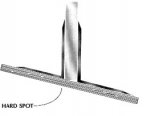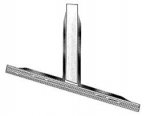There are several things I haven't understood about replacing a bulkhead and the use of foam cushioning or fillet joints or both, and tabbing, having never done this or seen it done before.
I thought the purpose of the foam or whatever (do you mean real peanut butter?) would be to place a cushion between the bulkhead and the hull to reduce the risk of a hard spot. But if you then cover the foam with hard filleting, does that defeat the purpose by creating a hardened structure in the form of filleting contacting the hull? Is the answer that the filleting would be flexible enough, much more so than the wood, and would not create hard spots? (My thought is to use a 2"x10"x27" piece of pressure treated wood for the bulkhead, replacing the 3/4" rotted plywood.)
If you tab over the foam with mat/woven roving/mat, is the hardened fiberglass also flexible and not likely to cause a hard spot?
I've understood that instead of the foam, I could just use some spacer to hold the bulkhead away from the hull then use filleting to suspend the bulkhead in place. Does that filleting withstand the pounding of the hull against waves over the years?
Is there any reason to do both filleting and fiberglassing? Is filleting enough without adding the fiberglass?
I am thinking that I should practice this operation with some scrap wood before attempting the real thing on the boat but I would like to understand these issues first.
Choice of Foam:
Some books (Fiberglass boat repair manual and Fiberglass boat repairs Illustrated) mention foam choices like airex, divinycell, or klegecell, but in looking at those product lines, it's not clear which foam is appropriate for the cushioning. Can someone answer that?
I've seen some postings that say just pick up some foam from a home improvement center. Is the purpose of the foam only temporary until I add the filleting or the fiberglassing so this is just as good as the airex?
Apparently there is a difference of opinion on the type of home builders foam (pink or blue?) but I haven't paid attention to that because I don't mind spending a little more to do the job right once.
I have had trouble finding anything on the preferred thickness of the foam but it sounds as though 1/2" to 3/4" will do. Any suggestions on that?
I have understood a major advantage of doing this is that it solves the problem for me of trying to cut the bulkhead in a shape that matches the shape of the hull. I might be able to get the old bulkhead out in one piece but a lot of it has rotted away, especially on the bottom where it would be most critical to match the shape.
I spent a few hours going through the postings but have not found answers to most of these questions. Does anyone care to help?
I also have to replace a stretch of rotted core but that's another issue.
I thought the purpose of the foam or whatever (do you mean real peanut butter?) would be to place a cushion between the bulkhead and the hull to reduce the risk of a hard spot. But if you then cover the foam with hard filleting, does that defeat the purpose by creating a hardened structure in the form of filleting contacting the hull? Is the answer that the filleting would be flexible enough, much more so than the wood, and would not create hard spots? (My thought is to use a 2"x10"x27" piece of pressure treated wood for the bulkhead, replacing the 3/4" rotted plywood.)
If you tab over the foam with mat/woven roving/mat, is the hardened fiberglass also flexible and not likely to cause a hard spot?
I've understood that instead of the foam, I could just use some spacer to hold the bulkhead away from the hull then use filleting to suspend the bulkhead in place. Does that filleting withstand the pounding of the hull against waves over the years?
Is there any reason to do both filleting and fiberglassing? Is filleting enough without adding the fiberglass?
I am thinking that I should practice this operation with some scrap wood before attempting the real thing on the boat but I would like to understand these issues first.
Choice of Foam:
Some books (Fiberglass boat repair manual and Fiberglass boat repairs Illustrated) mention foam choices like airex, divinycell, or klegecell, but in looking at those product lines, it's not clear which foam is appropriate for the cushioning. Can someone answer that?
I've seen some postings that say just pick up some foam from a home improvement center. Is the purpose of the foam only temporary until I add the filleting or the fiberglassing so this is just as good as the airex?
Apparently there is a difference of opinion on the type of home builders foam (pink or blue?) but I haven't paid attention to that because I don't mind spending a little more to do the job right once.
I have had trouble finding anything on the preferred thickness of the foam but it sounds as though 1/2" to 3/4" will do. Any suggestions on that?
I have understood a major advantage of doing this is that it solves the problem for me of trying to cut the bulkhead in a shape that matches the shape of the hull. I might be able to get the old bulkhead out in one piece but a lot of it has rotted away, especially on the bottom where it would be most critical to match the shape.
I spent a few hours going through the postings but have not found answers to most of these questions. Does anyone care to help?
I also have to replace a stretch of rotted core but that's another issue.





















